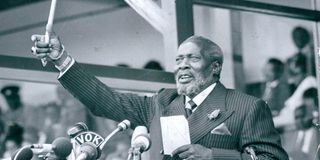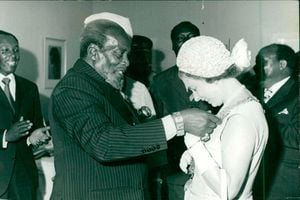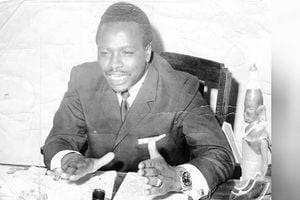
Former President Mzee Jomo Kenyatta.
In early 1946, Jomo Kenyatta’s passport had expired, and he wanted to sail back to Kenya after 15 years in Europe. He, perhaps, thought that the British might deny him passage, so he devised a strategy, according to some archives I was recently going through.
What was interesting was that on February 25, 1946, Jomo applied for permission to sail to the United States to carry out an “anthropological study of the country” while deep inside, he knew he was going back home. Actually, Jomo never visited America despite having so many friends.
By then, the British had put him on the “Stop List” on January 31, 1946, and he could not travel to East Africa without an endorsement.
Any such attempt had to be reported to the Kenya Colony. Whether this has come to Kenyatta’s attention is unknown.
In Sussex, where he lived during the war, he settled as a farm worker and part-time lecturer to British troops. The intelligence, it appears, had got tired of keeping surveillance on him.
Thus, when he applied to travel to the US, the intelligence, through Lt Col E.L Spencer, bought into this ruse.
Two days later, they sent a letter to the American Embassy saying they had “no objection”. They then alerted the Americans that Jomo was “at one time a communist” and that his “current leanings are towards Trotskyism”.
Global revolution
The Trotskyists believed in a global revolution that would alter the capitalist frameworks.
Although it had come to the intelligence’s attention that funds were being collected “to defray the cost of (Kenyatta’s) journey,” it is intriguing that they thought that he would sail “via the US”.
It is also surprising that they never saw Jomo board the ship — or his wife Edna accompanying him to the port.
Nairobi had always asked the British intelligence to alert them in case Kenyatta decided to return lest he caught them by surprise. Anticipating that he might sail to Kenya from the USA and avoiding any political showdown, they quietly revised the Stop List on April 1, 1946.
A note signed by I.C. Boyd said, “Kenyatta Johnstone can now go to East Africa without any further endorsement on his passport”.
It was a clever move, for an attempt to block his entry would have triggered an uproar. Previously, the MI5 Director Sir David Petrie told the intelligence in Nairobi, “should we get further information as to his movements, we will, of course, get in touch with you”.
In the same letter, Sir David informed Nairobi that Jomo had been granted a renewal endorsement to his British passport for travel to the USA.
“Although we have, in fact, warned the US authorities of his possible arrival there, it is likely that he will eventually make his way to East Africa without our knowledge, direct from the USA.”
But Kenyatta sailed back from Southampton almost incognito - catching the British intelligence and Nairobi by surprise.
On September 19, 1946, a secret telegram was sent to London from Nairobi seeking to confirm that Kenyatta sailed from there on “approximately September 5”.
Another note was dispatched to Sussex Police — who should have kept tabs on him — seeking confirmation of that report. Apparently, they had no idea that the man had left Europe.
A secret Telegram
A week later, on September 26, Nairobi confirmed their nightmare: “Kenyatta arrived in Nairobi today”, they wrote in a secret Telegram sent to London police in Sussex.
By this time, Police in Sussex were still conducting a futile search for Kenyatta by calling his former home at Highover, Heath Common.
After hitting a dead end, they wrote back: “Enquiries in the vicinity have also been without result and I am unable to find any trace of his recent movements.”
Kenyatta's arrival without the knowledge of the East Africa Security Liaison Officer, C.J. Mason, an MI5 top official, embarrassed the security. Even then, top newspapers did not cover his arrival.
It was now time to lick the wounds of embarrassment. Mason protested: “You will note that our London office undertook to inform us of Jomo Kenyatta’s movements, providing that he made a direct journey to East Africa from the UK. This undertaking, unfortunately, was not fulfilled, and, accordingly, we were not able to inform the Director of Intelligence Service (in) Kenya as we had promised.
“Kenyatta, as we have already informed you, arrived in Nairobi today, and the only notification we had of his impending return was a notice to this effect in a local African newspaper.”
Mason called it an “unfortunate matter” and said their only solace was a “cordial relationship” with the Director of Intelligence, Mr Sandwith. Had one of the other rather less friendly Directors of Intelligence and Security been involved, ‘our loss of face’ would have been more humiliating.
It was not the first time Kenyatta had outwitted the intelligence. In 1942, the Director of Intelligence in Nairobi, W. Riggs, wrote to Sir David Petrie, the Director General of MI5, informing him that they had overheard Kenyatta's eldest son, Peter Muigai, saying that his father was now sending letters to a Frenchman in Kenya “and they were then passed to the people to whom they were meant”.
In his reply dated July 28 1942, Sir David Petrie acknowledged that they had not been paying attention to Kenyatta, and it appears that they had thought that Kenyatta had lost interest in politics.
“Nothing of interest was discovered after May 1940 (but) it is possible of course, that he continues to correspond with his associates in Kenya perhaps through the medium of coloured seamen.”
That could explain why the Police in Sussex had no information on Kenyatta’s departure. They were also surprised that Kenyatta had married a local girl, Edna Clarke, without their knowledge.
Legally married
Again, the liaison office in Nairobi would trigger that investigation: “Could you confirm if Mrs (Edna) Kenyatta is legally married or is a mistress?” stated the Telex dated October 19, 1946.
“To everyone’s surprise, the search at the Marriage Register at Sommerset returned nil, so they decided to widen the search since Sommerset only covered England and Wales. If there is any possibility of the Kenyattas being married in Scotland or Northern Ireland, reference may be obtained from Edinburgh and Belfast, respectively,” it was suggested.
That marriage certificate would later be found in Somerset House, and it confirmed that Kenyatta married Edna on May 11, 1942, and was witnessed by C Leigh Browne (Kwame Nkrumah had a girlfriend with the same surname) and A.S. Johnson.
The security officers in Nairobi also asked London to inform them when Mrs Kenyatta applied for a passport and sought to travel abroad. By this time, she had also come to the attention of MI5: “Since it is possible that she may elect not to travel to Kenya direct, it would also be of interest, in these circumstances to know which countries she may request her passport to be validated,” wrote P. Perfect, the EA Security Liaison Officer to Sir Percy Sillitoe of MI5.
In his reply, Sillitoe said, “Her name is now included in the Stop List, and should she apply for passport facilities, the application will be immediately brought to our attention.”
They then started opening and copying all her letters as she struggled to stay out of Kenyan politics as much as possible. Unlike most of the other women activists who surrounded Jomo in London – Nancy Cunard, Dinah Stock, and Sylvia Pankhurst, among others – Edna was different.
She only cared much about her son, Peter Magana. She also had the support system of Kenyatta’s many comrades in the UK.
Meanwhile, having beaten the intelligence into their own game and with the highly charged rallies that he was addressing, it was a matter of time before they fixed him.
And they did later on.







